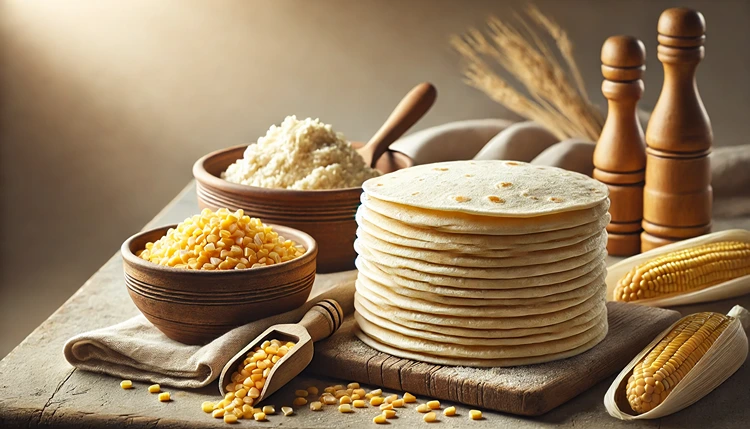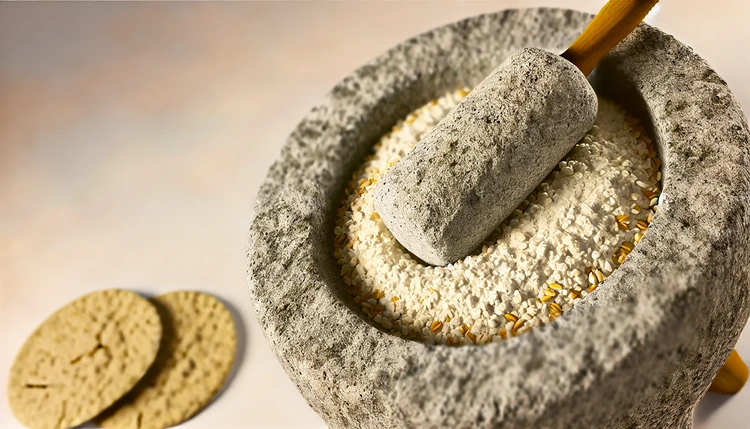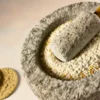When you think about Mexican cuisine, tortillas are probably one of the first things that come to mind. But have you ever wondered about the ancient process behind making those soft, flavorful tortillas? The secret lies in an old method called the Nixtamalization Process, which has been used for centuries to make Aztec tortillas. Let’s explore what it is, how it works, and why it’s still relevant today.
What is the Nixtamalization Process?
Nixtamalization might sound like a complicated word, but it’s a simple process with a rich history. Essentially, it’s the technique of cooking dried maize kernels in an alkaline solution, usually limewater (calcium hydroxide). This process transforms the maize, making it easier to grind and digest while boosting its nutritional value. For the Aztecs, it wasn’t just about making tortillas easier to handle; nixtamalization also made the food more nutritious.
Why Did the Aztecs Use Nixtamalization?
The Aztecs were ahead of their time in terms of food preparation. They figured out that treating maize with an alkaline solution unlocked more nutritional benefits from the grain. This was important for their diet, as maize was a staple food. The nixtamalization process made the maize more digestible and added essential nutrients like calcium and niacin, which were key for the Aztecs’ health and well-being.
Helpful Hint:
Nixtamalization doesn’t just improve the nutritional value of maize; it also enhances the flavor and texture, which is why tortillas made using this method are so iconic.
How Does Nixtamalization Work?
It’s all about chemistry, but don’t worry, you don’t need a lab coat for this one! Here’s a breakdown of how nixtamalization happens:
- The dried maize kernels are soaked and cooked in an alkaline solution, usually made from water and lime.
- The maize is left to steep for several hours, allowing the lime to break down the hulls of the kernels.
- After steeping, the maize is rinsed thoroughly to remove any excess lime.
- What’s left is nixtamal, which can be ground into masa (dough) to make tortillas or other foods.
What Happens to the Maize?
During the nixtamalization process, the limewater causes a chemical reaction that breaks down the tough outer shell of the maize kernels. This makes the maize softer and easier to grind. It also allows the release of niacin, a key nutrient that would otherwise remain locked in the grain. The result is a dough that’s perfect for making tortillas, tamales, and more.
Why is Nixtamalization Still Important?
Even though modern food processing methods have evolved, nixtamalization remains important for making authentic Aztec tortillas. It’s not just about tradition; it’s about creating a superior product. Tortillas made with nixtamalized maize have a distinct flavor and texture that can’t be replicated with untreated maize. Plus, you get those extra nutritional benefits that come from the process.
Can You Make Nixtamalized Tortillas at Home?
Yes! With the right ingredients and a bit of time, you can try nixtamalizing maize at home. While it might seem like a long process, it’s worth the effort if you’re aiming for authentic tortillas. All you need is dried maize, lime (calcium hydroxide), and water. Below is a basic recipe for nixtamalized tortillas.
Homemade Nixtamalized Tortillas

Ingredients
- 2 cups dried maize kernels (preferably hominy)
- 2 tablespoons calcium hydroxide (lime)
- 6-8 cups water
Instructions
- In a large pot, combine the water and lime, stirring until the lime is dissolved.
- Add the maize kernels to the limewater and bring it to a boil.
- Once it’s boiling, lower the heat and simmer for about 30 minutes.
- Turn off the heat and let the maize soak in the limewater for at least 12-16 hours.
- After soaking, rinse the maize thoroughly under cold water to remove any lime residue.
- Grind the nixtamal into masa using a corn grinder or food processor.
- Use the masa to shape and cook your tortillas on a hot griddle or comal.
Notes
Be sure to rinse the maize well after soaking to remove excess lime. This step is crucial for both flavor and safety.
Is Nixtamalization Used for Anything Besides Tortillas?
Absolutely! While tortillas might be the most famous product of nixtamalization, the process is also used to make tamales, pupusas, and even some beverages. Nixtamalized maize is the foundation of many traditional dishes, giving them that distinctive taste and texture.
In fact, in some regions of Mexico, nixtamalized maize is used to make atole, a thick, warm drink that’s perfect for cold mornings. The possibilities are endless once you start working with nixtamalized maize!
Helpful Hint:
If you’re looking to get creative in the kitchen, try using nixtamalized maize in new ways. It’s a versatile ingredient that can be incorporated into everything from snacks to full meals.
How Does Nixtamalization Affect the Flavor of Tortillas?
The nixtamalization process doesn’t just change the maize physically—it also has a big impact on the flavor. When maize is treated with lime, it develops a subtle, nutty taste that’s much more complex than untreated corn. This flavor is what sets authentic Aztec tortillas apart from their modern, store-bought counterparts.
Additionally, the process removes the bitter taste often associated with raw corn. Instead, you’re left with a soft, slightly earthy flavor that pairs perfectly with traditional Mexican dishes like tacos and enchiladas. The texture also becomes more pliable, making it easier to shape and cook.
Why You’ll Notice the Difference
If you’ve ever had freshly made tortillas in a traditional Mexican kitchen, you know the difference is immediate. Store-bought tortillas can’t match the flavor, texture, or freshness of those made using nixtamalized maize. You get a taste of history in every bite—a reminder of the Aztec ingenuity that made this process so essential to their cuisine.
Key Differences Between Nixtamalized and Non-Nixtamalized Maize
| Aspect | Nixtamalized Maize | Non-Nixtamalized Maize |
|---|---|---|
| Digestibility | More easily digestible due to broken-down components | Harder to digest; retains tough outer shell |
| Nutrition | Contains more bioavailable niacin and calcium | Lower nutrient availability, especially niacin |
| Flavor | Earthy, nutty, slightly tangy flavor | Less complex, raw corn flavor |
| Texture | Softer and more pliable | Harder, grainier texture |
| Cooking Uses | Ideal for tortillas, tamales, atole | Used for cornmeal, popcorn, etc. |
What Are the Nutritional Benefits of Nixtamalization?
One of the key reasons the Aztecs relied on nixtamalization was for its nutritional advantages. When maize is treated with limewater, the process enhances its nutrient profile in several ways:
- Increased Calcium: The calcium from the lime is absorbed by the maize, boosting its calcium content. This was especially important in the Aztec diet, as calcium helps maintain strong bones and teeth.
- Better Digestibility: The alkaline solution breaks down certain components of maize that are difficult to digest. Nixtamalized maize is easier on the stomach and more bioavailable.
- Release of Niacin: Nixtamalization unlocks niacin (vitamin B3), a vital nutrient for energy production and overall health. Without this process, maize alone wouldn’t provide the same level of nutrition.
These benefits made nixtamalization more than just a cooking technique—it was a cornerstone of health for the Aztecs and continues to be an essential process for millions today.
Helpful Hint:
Niacin is an important nutrient for brain function and skin health, so tortillas made with nixtamalized maize offer more than just flavor—they’re a nutritional powerhouse!
Modern Uses of Nixtamalization
While the process has ancient roots, nixtamalization is still widely used today. In fact, many modern Mexican households continue to nixtamalize maize the same way their ancestors did, ensuring that traditional tortillas retain their flavor and nutritional value. In industrial settings, the process has been adapted for large-scale production, but the principles remain the same.
Nixtamalization Beyond Tortillas
The uses of nixtamalization extend beyond tortillas and tamales. For example, it’s a key step in making masa for pupusas in El Salvador and even in some American corn products, like hominy. Additionally, nixtamalization plays a role in brewing Mexican beverages like pozol, a drink made from fermented maize dough.
Is Nixtamalization Environmentally Friendly?
Compared to modern methods of corn processing, nixtamalization is relatively eco-friendly. The process relies on natural ingredients—water, maize, and lime—without the need for chemicals or extensive machinery. As a result, the environmental impact is low, particularly when practiced on a small, traditional scale. This makes it an appealing option for those looking to prepare food in a sustainable way.
Of course, industrial-scale nixtamalization does produce more waste, but innovations are being developed to make the process greener. For example, companies are working on ways to recycle limewater and reduce waste in large production facilities.
How to Store Nixtamalized Maize
If you’re making nixtamalized maize at home, proper storage is essential to maintain freshness. After rinsing and draining your nixtamal, you can store it in an airtight container in the refrigerator for up to a week. If you want to keep it longer, you can freeze the nixtamal for several months. Just be sure to thaw it completely before using it to make masa for tortillas.
Storing Masa for Later Use
If you’ve already ground your nixtamal into masa, you can store it in a similar way. Wrap the masa tightly in plastic wrap or place it in a ziplock bag, and refrigerate it for up to 3 days. For longer storage, masa can also be frozen and used later, although the texture may change slightly after freezing.
Keep in mind that fresh masa always gives the best results, so try to use it within a few days for the most authentic flavor and texture.
FAQs
Wrapping Up
The Nixtamalization Process for Aztec Tortillas is a cornerstone of authentic Mexican cuisine and has stood the test of time for a reason. By transforming dried maize into a more digestible, flavorful, and nutrient-rich ingredient, this ancient method laid the groundwork for countless traditional dishes, from tortillas to tamales. Whether you’re looking to recreate Aztec tortillas at home or simply appreciate their historical significance, understanding nixtamalization provides a deeper connection to Mexican culinary heritage. This method is more than just a cooking technique—it’s a celebration of ingenuity and culture. So, next time you enjoy a tortilla, remember the process that made it possible, and consider trying it at home for a truly authentic taste of history.








